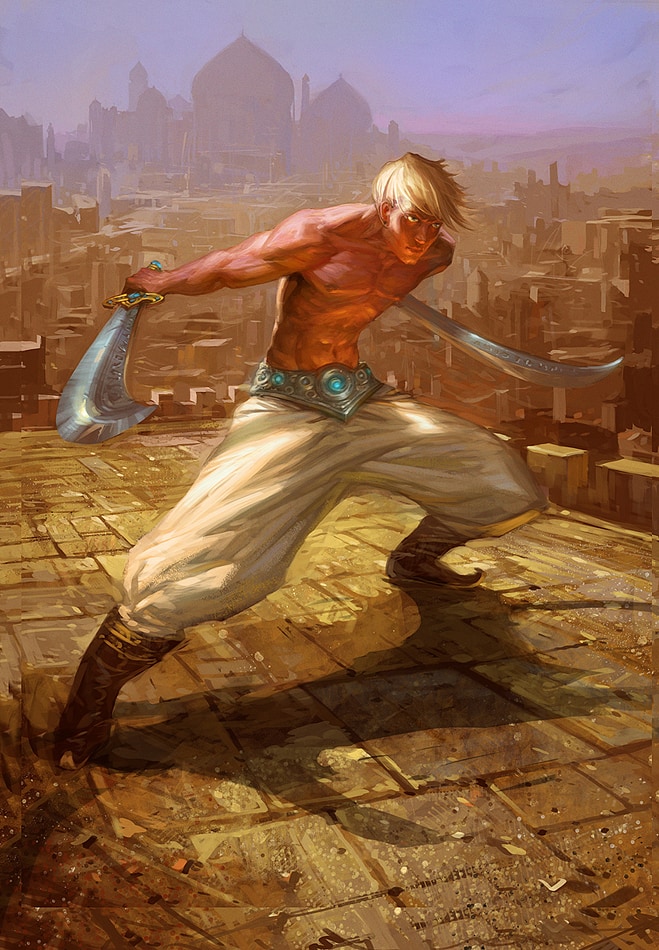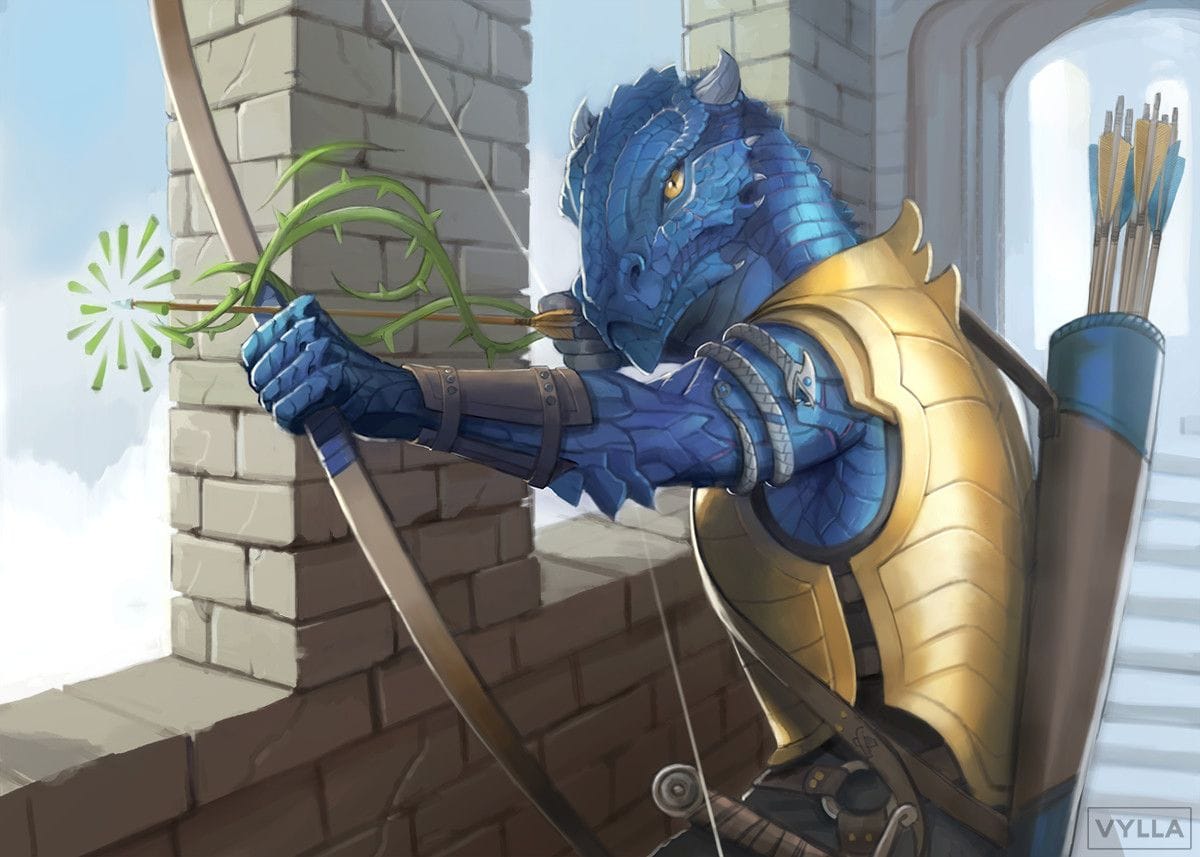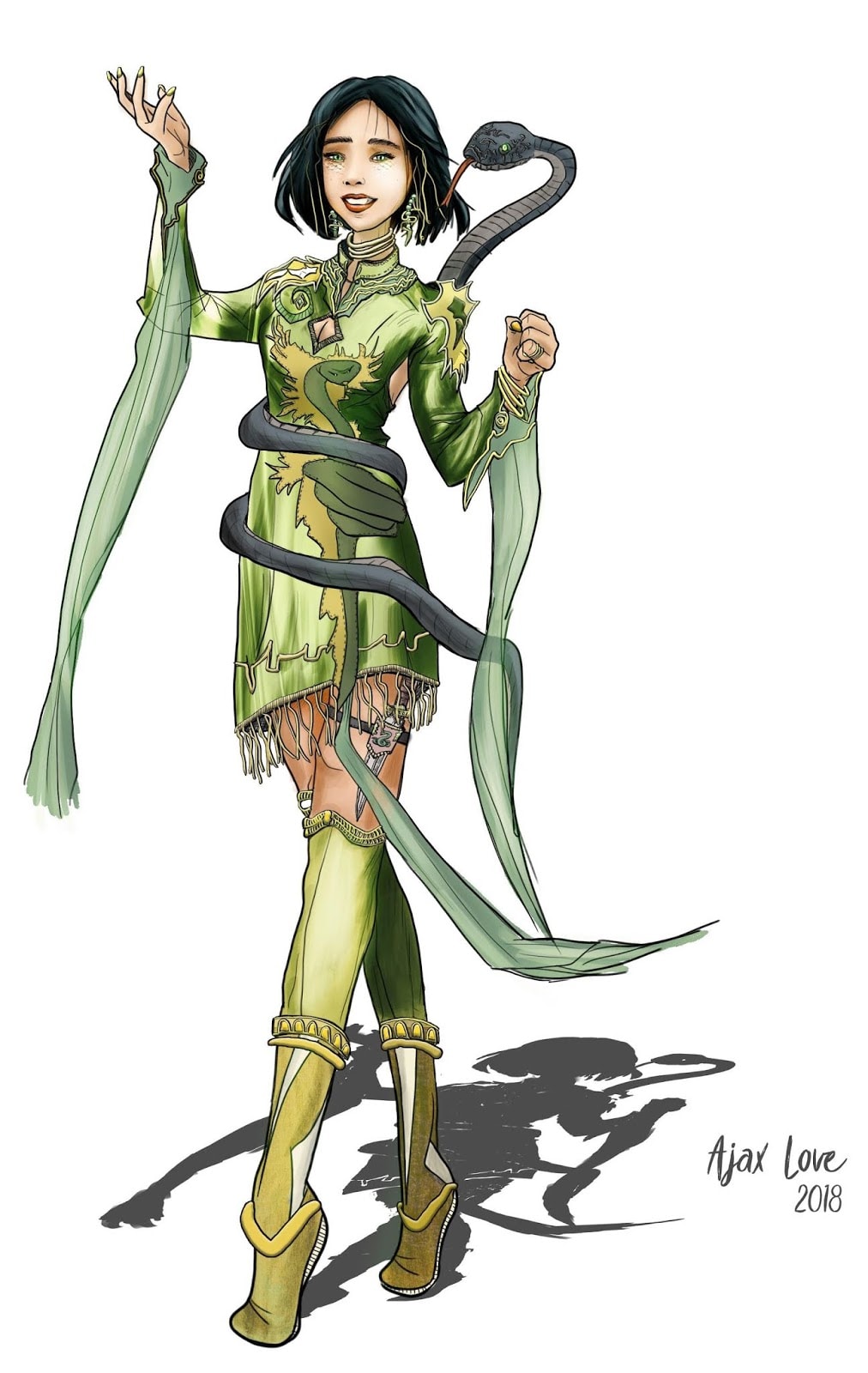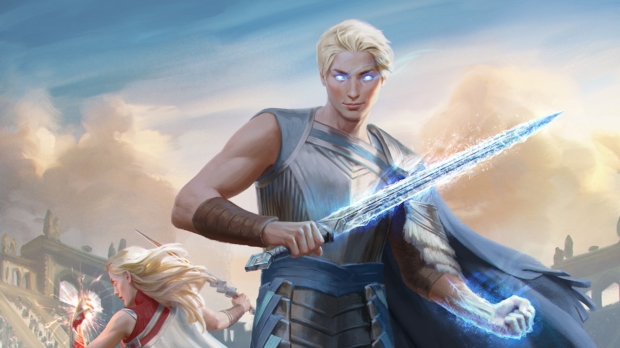The Caves of Chaos turned out to be more of a challenge than she thought. The cries of battle let her know that her companions were occupied. The drow warlock was on her own. As the three kobolds closed in, she considered her options. Should she use Blade Ward? Welcome to a Blade Ward 5e Guide.
What is Blade Ward?
Blade Ward is an abjuration cantrip. This means that Blade Ward is of an Arcane Tradition that focuses on protection magic. Unlike spells that can only be cast a limited number of times before a long or short rest, cantrips can be cast at will.
The user traces a special sign in the air, a sigil of warding. Until the next turn, the user has resistance to most types of damage from weapon attacks: bludgeoning, piercing, and slashing damage. That means that such weapon attacks do only half the damage.
Here are the cantrip’s stats as they appear in the Player’s Handbook (PHB), p. 218-219.
Blade Ward
- Abjuration cantrip
- Casting Time: 1 action
- Range: Self
- Components: V, S
- Duration: 1 round
At Higher Levels

Unfortunately, improvement at this spell at the higher levels is not covered within PHB.
Who can use Blade Ward?
The Blade Ward cantrip is available to the following classes within PHB: bard, sorcerer, warlock, and wizard. Within PHB, it is also available to the following subclasses: eldritch knight and arcane trickster.
How to use Blade Ward
You don’t pick the target because the target is yourself.
You don’t need to meet the level requirements because Blade Ward is a 0-level spell available to even 1st level characters.
You don’t need to prepare the spell because cantrips don’t require preparation.
- You need enough time within your turn to complete 1 action.
- You need to be able to move one hand to trace a sigil in the air, the somatic component. You need to be able to speak and utter some magical words.
- You need to let the DM (dungeon master) know that casting Blade Ward is your intended action for your turn.
Is Blade Ward good?
No. For most players, Blade Ward is not good.
The major weakness of Blade Ward is that the casting time is 1 action and that the duration is 1 round.
If your DM wants to homebrew the rules to allow Blade Ward to be cast as a bonus action or give it a longer duration, it would be more viable. With Blade Ward as it is in PHB, it’s probably not worth taking. As the Warlock vs Kobolds Battle below will show, there are usually way better options out there, even for low-level characters.
Warlock vs Kobolds Battle

Semiramis, the drow warlock, and her party are trapped in a cave and engaged in a fierce struggle against a tribe of kobolds. The kobolds have superior numbers. All of the party’s tanks are preoccupied, so the party’s warlock and wizard are left to fend for themselves. Even though some kobolds are killed by the party’s ranged attacks, including Semiramis’s Eldritch Blast, they have now closed the distance to within 5 feet.
The party has already killed several kobolds previously, exhausting most of their heavy damage-dealing spells, including Semiramis’s Sleep Spell. Semiramis has to deal with 3 kobolds at close range by herself. Because Semiramis has 16 Dexterity, she manages to get her turn on the initiative before the kobolds do.
Semiramis has four options:
- Non-magical melee
- Non-magical defense (Dodge)
- Eldritch Blast
- Blade Ward
Non-magical melee
Semiramis has 2 shortswords.
She can attack 1 kobold with her 2 shortswords using her Two-Weapon Fighting Bonus action.
Her primary attack will have +5 attack/+3 damage for 1d6+3 damage (4-9 total), and her bonus attack will have no modifiers for attack or damage and simply do 1d6 damage. If both attacks hit 1 kobold, Semiramis’s total damage will be 5-15 damage points.
She can also attack 2 kobolds with her 2 shortswords.
Kobold 1 would receive her primary attack at +5 attack/+3 damage for 1d6+3 damage (4-9 total).
Kobold 2 would receive her bonus action attack at no modifiers and 1d6 damage.
Non-magical defense (Dodge)

If Semiramis makes Dodge her action, she can do nothing else. However, every attack on her would be at a disadvantage. Since Semiramis has a Dexterity of 16 and is wearing studded leather armor, her Armor Class is 15.
Unfortunately for Semiramis, these kobolds have the Pack Tactics ability. This means that their attacks against her will be at an advantage as long as 2 or more of them are still alive. Basically, their Pack Tactics advantage would cancel the disadvantage they would have against Semiramis’s Dodge.
Eldritch Blast
At the time of this battle, Semiramis is a 2nd-level character, so she has access to the Agonizing Blast invocation. That means she can add her Charisma modifier (+3) for a damage total of 4-10 per round. However, since Eldritch Blast is a ranged spell attack and the kobolds are within 5 feet of her, her attacks would be at a disadvantage.
Blade Ward
Semiramis can cast Blade Ward as her action for this round and each round thereafter until the battle is over. Semiramis would not be able to attack or cast any other spells, but the damage from the kobold’s attacks would be halved.
The Decision
Semiramis’s player, Sally, is given a couple of extra minutes by the DM to decide what to do with her turn. In the real world, a combatant would have less than a second to decide, but we want to have a good game.
Blade Ward

Sally briefly considers her cantrip. She’s actually looked at the Monster Manual before, so she knows the stats for kobolds. For offense, here are their stats:
Dagger: +4 attack/+2 damage. Damage 1d4+2 (3-6 total) piercing
Because the kobolds are using daggers, weapons that do piercing damage, this damage will be halved by the Blade Ward cantrip. Since the average damage per kobold dagger strike is about 4 points, each hit will do 4 points of damage to Semiramis. However, such damage will be halved, so each successful kobold dagger-strike will do 2 points of damage.
Semiramis has 16 hit points so she can survive 8 kobold dagger strikes before she goes to 0, provided she is using Blade Ward for each round. If Semiramis is getting hit by dagger strikes 45% of the time, Sally estimates that Semiramis will take 3 dagger strikes for every 6 attacks leveled at her if you round up. That means, according to Sally’s calculations, Semiramis can survive about 3 rounds with these kobolds before her hit points are reduced to -2.
Sally knows if the other party members can overcome their own kobolds within the next 2 rounds, Blade Ward should keep Semiramis alive long enough to be rescued. If any of the party members get finished off by the kobolds, those kobolds will be free to attack other party members, including Semiramis. That means that Semiramis might eventually have more than 3 kobolds to deal with.
This Pack Tactics problem, coupled with the fact that Semiramis wouldn’t be able to take any offensive actions herself, makes Sally choose to pass on Blade Ward. She decides to pass on Dodge for the same reason.
Instead, Sally opts for a non-magical melee attack. She smiles as she announces her decision to the DM.
“I use my 2 shortswords to attack 2 kobolds.”
Semiramis kills all 3 kobolds within 2 rounds. She suffers 4 hit points of damage, but with 12 hit points remaining, she’s still in the fight.
Interesting Read: Comprehensive Guide to Daggers in DnD 5e.
Analysis
For low-level characters, they need to understand that they will start out fighting low-level monsters. A lot of these low-level monsters will have Pack Tactics: kobolds, wolves, giant rats, etc. Pack Tactics pretty much negates Blade Ward anyway because your opponents will attack at an advantage. Your damage may be halved, but your opponents are twice as likely to hit you.
Blade Ward doesn’t do anything to stop your attacker or make your character invulnerable, it simply delays your character’s death in the hopes that other party members can rescue you. So, then the question is, how much time does Blade Ward buy you?
In Semiramis’s case, it would have bought her about 2 rounds. With her AC 15 and the +4 attack advantage of the kobolds, each kobold would need an 11 to hit her. However, with an advantage, each kobold would get to roll twice each round. Most likely, all 3 kobolds would hit her every round.
Semiramis has 16 hit points. If all 3 kobolds hit her for the first round, they would average 4 damage points each and do a total of 12 points of damage. Due to Semiramis’s Blade Ward spell, those 12 damage points would become 6 damage points.
Semiramis would start round 2 with 10 hit points. Because she is casting Blade Ward, she can’t do anything else. The kobolds would attack again and deduct another 6 damage points.
Semiramis would start round 3 with 4 hit points. If none of her companions could be freed up from fighting to intervene before the kobolds get their turn to attack for the 3rd round, they would do another 6 damage points and reduce Semiramis to -2 hit points. At this point, Semiramis would no longer be able to cast Blade Ward and would be close to death.
Had Semiramis been fighting giant rats, they would have also had Pack Tactics, and she wouldn’t have even been able to use Blade Ward at all. Rats don’t carry weapons, and Blade Ward is not Tooth Ward.
Blade Ward is only good for specific situations, and even then, it is usually only moderately helpful. It does nothing to help the other party members and usually buys you only a very short amount of time while all you can do is wait to be rescued.
Squishy Characters

The pro-Blade Ward crowd would say that it is good for squishy characters. Warlocks and bards might not be squishy enough because they have light armor, some martial weapons, and a slightly better hit die for creating hit points. The truth is, Blade Ward can suck even more for squishy characters because Blade Ward buys them even less time because they have even fewer hit points.
On the other hand, they have even fewer options because their melee capabilities tend to suck. Regardless, there’s almost always a better option than Blade Ward. For most characters choosing Blade Ward means that they can pick one less cantrip. Even if they have access to any cantrip they want in a fight, the action of casting Blade Ward means that you can’t do anything else.
To demonstrate my point, however, let’s replace Semiramis with a squishy character. This 2nd level squishy character is fresh out of 1st level spells and has to deal with 3 kobolds by herself until her companions are free to help her.
Our squishy character is Yan Wei, the Yuan-Ti Pureblood Wild Magic Sorcerer. She’s squishy because she was really designed for palace intrigue, not dungeon adventuring. Her basic stats:
| Lvl | AC | HP | Modifier A/D | Light Crossbow | Dagger | 2 Daggers |
| 2 | 11 | 12 | +3/+1 | 1d8 +1 (2-9) | 1d4 +1 (2-5) | 1d4 +1 + 1d4 (3-9) |
| STR | DEX | CON | INT | WIS | CHA |
| 8 (-1) | 12 (+1) | 13 (+1) | (+3) | (+0) | 16 (+3) |
Her options are not nearly as good as those of Semiramis:
- Blade Ward
- Melee
- True Strike/Ranged Attack combo
- Minor Illusion/Poison Spray combo
Blade Ward
With her 12 hit points, it would buy her 1 round. Let’s say Wan Tei had the foresight to cast Mage Armor at the start of her adventuring day. That would bring her AC to 13, with a total of 14 when you add her +1 Dexterity modifier. All three kobolds, with their Pack Tactics advantage on rolls, would probably all hit her on the first round. They would do an average of 12 damage points, but that would be halved to 6 damage points.
Wan Tei would start the second round with 6 hit points. If her companions can’t rescue her before the 3 kobolds attack again, she would be reduced to 0 hit points by the end of the 2nd round. Making Blade Ward a less than useful cantrip for this situation.
Creative and Useful Ways to Use Blade Ward in 5e D&D
If you’re going to use Blade Ward at all, you have to get creative.
Concentration Checks
Let’s say when Semiramis levels up, she wants to pick Cloud of Daggers, a 3rd level spell. Cloud of Daggers has a duration of up to 1 minute, but it’s a concentration spell. That means that if Semiramis takes damage while holding her concentration, she will have to make a Constitution saving throw. The save will be at DC 10 or half the damage she takes, whichever is higher.
Because casters can cast other non-concentration spells during a concentration spell, including Blade Ward, casters can use this cantrip to halve the damage they take. Would that greatly improve your chances of maintaining concentration? Possibly not.
Every successful damage attack requires a Constitution save at DC 10 or more, regardless of damage. That means that the only attacks that will require a Constitution save at higher than DC 10 will be attacks that do 22 points of damage or more in a single strike. Spell attacks might do that kind of damage, and so would a bite from a giant monster, but Blade Ward is useless for that kind of stuff. How many opponents have the ability to use a weapon to do 22 points or more in a single attack?
For most casters, if they find themselves dealing with such an opponent, maybe holding their concentration is the least of their problems. Still, different players have different styles. Personally, if I’m wielding a concentration spell, I don’t want something that’s going to allow me to take half damage; I want something that’s going to keep me from taking any damage.
Quickened Spell
Sorcerers have access to Metamagic when they reach 3rd level. They have to choose two types of Metamagic they can use. If Quickened Spell is one of those two types, Blade Ward can be applied the following way.
The sorcerer that uses Quickened Spell can cast Blade Ward as a bonus action rather than as an action for the price of 2 sorcery points. That way, the sorcerer could still fight and cast other spells while using Blade Ward. The only problem is that those 2 sorcery points only count for that one round of casting. If you want to cast Blade Ward again as a bonus action for the second time, you’d have to use 2 more sorcery points. Imagine having to burn 2 sorcery points per round just to make it, so your Blade Ward doesn’t suck?
War Magic

War Magic is a feature for the Eldritch Knight archetype of fighters when they reach 7th level. When an Eldritch Knight with War Magic casts a cantrip, including Blade Ward, he or she gets one attack as a bonus action.
An Eldritch Knight with War Magic is going to have the multi-attack ability. Such a character would have to give up the extra attack(s) just to throw Blade Ward. However, for certain situations when the Eldritch Knight’s job is simply to delay some opponents, this War Magic/Blade Ward might be the right choice.
Armor of Agythys

Armor of Agythys gives you 5 temporary hit points that are capable of doing 5 points of cold damage whenever you are stricken with a melee attack. Blade Ward could make your 5 temporary hit points last longer. Let’s use this for the battle between the 3 kobolds and Semiramis:
Armor of Agythys with Blade Ward
All 3 kobolds hit, doing 6 damage points total and destroying the temporary hit points provided by the Armor of Agythys.
All 3 kobolds take 5 points of damage and die by their own attacks, committing koboldicide.
Semiramis suffers 1 hit point of damage.
Armor of Agythys without Blade Ward
Semiramis gets the initiative through her Dexterity and kills 1 kobold through melee.
The 2 surviving kobolds counter-attack. The 1st kobold hits her, does 4 damage points to her 5 temporary hit points, and commits koboldicide. The 2nd kobold hits does 1 damage point to her remaining temporary hit points and 3 damage points to Semiramis’s 16 hit points. The Armor of Agythys is destroyed, but the last surviving kobold also perishes by koboldicide.
Blade Ward did help, but not by much. The Armor of Agythys lasted a little longer with Blade Ward, and Semiramis suffered 2 hit points less damage.
FAQs
Question: Does Blade Ward help against unarmed attacks?
Answer: No. It’s called Blade Ward, not Fist Ward.
Question: Does Blade Ward protect against magic weapons?
Answer: Yes. Provided that the damage type is bludgeoning, slashing, or piercing.
Question: Does a trap count as a weapon regarding Blade Ward?
Answer: If I’m the DM, absolutely. This cantrip sucks enough as it is. No need to make it suck even more.
Question: Is Blade Ward a concentration spell?
Answer: No. If for some reason, the character has time for other bonus actions within a turn, those actions can be completed while casting Blade Ward. However, Blade Ward still requires a full action for each turn that it is cast unless you use Quickened Spell.
Conclusion
When I first made the transition from 1e to 5e, I got sucked into the Blade Ward trap too. As I learned more about the spell itself and the game as played in 5e, I learned to regret taking that spell. That’s ok, getting sucked into taking bad spells is part of the game. That’s how we learn best, through our mistakes.
What Blade Ward teaches us is the value of Action Economy. Action Economy is a concept that gets tossed around in the RPG world because your turns during combat are so valuable. The choices you make during your turn can make the difference between life and character death. If you’re in a large party, you will have a long wait between turns. Making a bad choice means that you have nothing to do for the rest of the round but watch the outcome of your bad decision play out until your turn comes again. Blade Ward is usually a bad spell/cantrip because it takes away your character’s choice to commit an action without giving you much in return.
That being said, there’s more than 1 kind of spell/cantrip because there’s more than one kind of player out there. Eldritch Knights and Armor of Agythys addicts might wreak havoc with a couple of well-placed Blade Wards. Because Blade Ward is a cantrip, they don’t have to use it for the whole fight. Instead, they can mix it up with other spells and attacks to frustrate and confuse opponents. Just like with any other tool, it’s all in how you use it.
- Perform Bewitching 5e Guide - October 1, 2022
- Inspiring Leader 5e Guide - September 20, 2022
- Scrying 5e Guide - September 19, 2022

